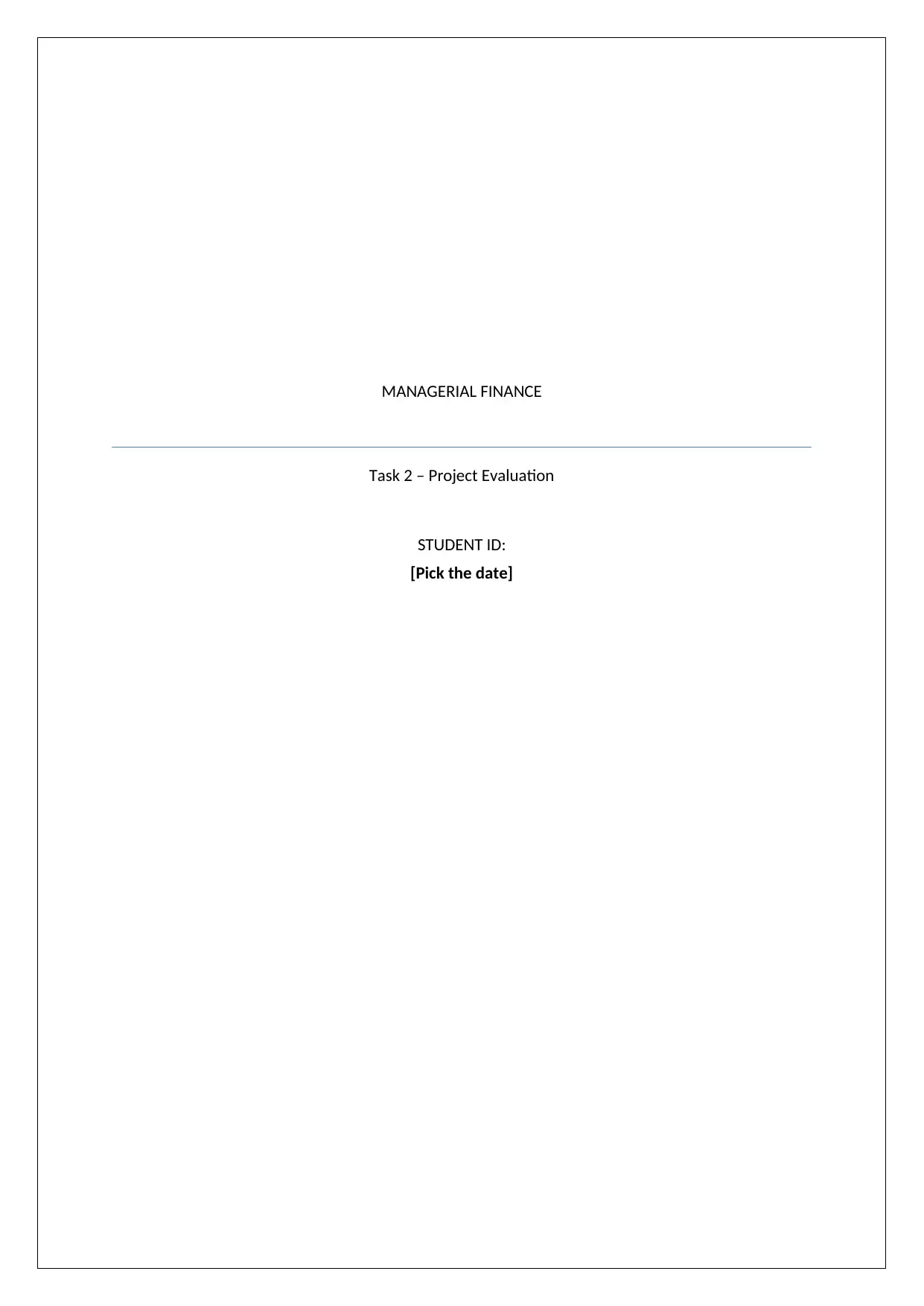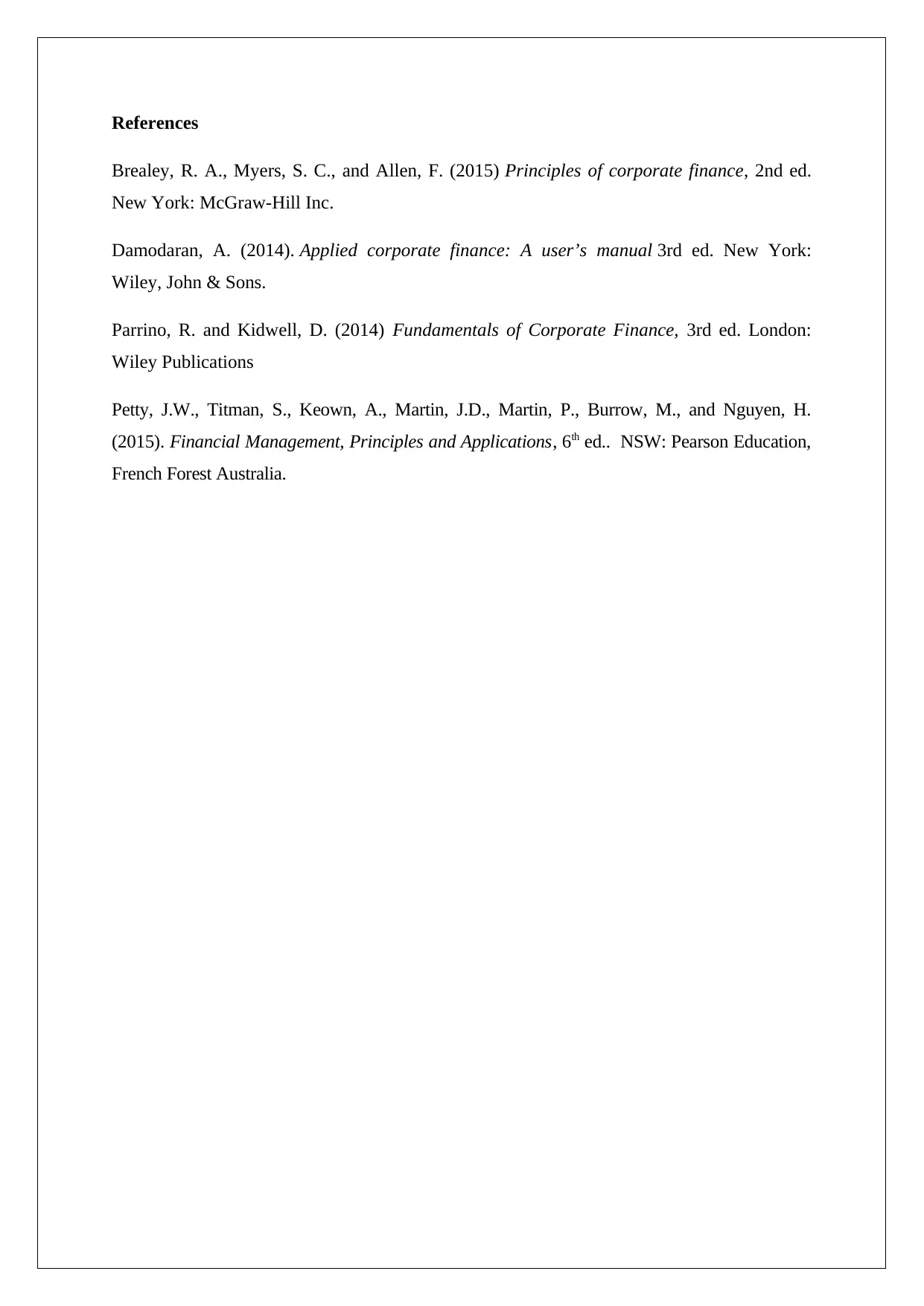Project Evaluation: Capital Budgeting Analysis for New Plant Setup
VerifiedAdded on 2023/06/11
|5
|771
|101
Project
AI Summary
This assignment provides a comprehensive project evaluation for a Brisbane-based manufacturing firm considering a new plant setup. The analysis includes calculating the project's cash flows over a 10-year period, considering initial costs, salvage value, refurbishment expenses, and annual after-tax ...

MANAGERIAL FINANCE
Task 2 – Project Evaluation
STUDENT ID:
[Pick the date]
Task 2 – Project Evaluation
STUDENT ID:
[Pick the date]
Paraphrase This Document
Need a fresh take? Get an instant paraphrase of this document with our AI Paraphraser

Question 1
a) As per the given details, a Brisbane based manufacturing firm intends to setup a new plant
which would have an estimate life of 10 years. The summary of the expected cash flows as
provided is detailed below.
For the given project, an upfront cost of $ 3 million would be required.
It is expected that at the end of useful project life, the salvage value (post tax) of
the equipment purchased at t=0 would be $ 200,000 or $ 0,2 million.
Also, it is known that at t-5, the machine would require refurbishment which would
lead to an incremental cash flow of $ 2 million
Besides, it is known that for all the 10 years of useful life of the project, the after
tax profits generated would be $ 0.7 million annually.
One of the pivotal elements which is taken as a cost for computation of after tax profits is
depreciation. Thus, in the computation of $ 0.7 million annual after tax profits, depreciation
has been deducted. However, depreciation is a non-cash based expense and hence needs to be
added back (Damodaran, 2015).
Equipment Initial Cost = $ 3 million
Salvage Value = $ 0.2 million
Annual Depreciation using the straight line method = (3-0.2)/10 = $ 0.28 million
However, incremental expenditure of $ 2 million has been incurred at t=5, hence this amount
would be added to the depreciation in the later years (Petty, et. al., 2015).
Thus, incremental depreciation from 6th year onwards = 2/5 = $ 0.4 million
From the above discussion, the following depreciation would be added so as to obtain the
project cash flows.
From t=1 to t=5, annual depreciation charge = $ 0.28 million
From t =6 to t=10, annual depreciation charge = $ 0.28 + $0.4 = $ 0.68 million
Considering the above, the project cash flows are estimated below.
a) As per the given details, a Brisbane based manufacturing firm intends to setup a new plant
which would have an estimate life of 10 years. The summary of the expected cash flows as
provided is detailed below.
For the given project, an upfront cost of $ 3 million would be required.
It is expected that at the end of useful project life, the salvage value (post tax) of
the equipment purchased at t=0 would be $ 200,000 or $ 0,2 million.
Also, it is known that at t-5, the machine would require refurbishment which would
lead to an incremental cash flow of $ 2 million
Besides, it is known that for all the 10 years of useful life of the project, the after
tax profits generated would be $ 0.7 million annually.
One of the pivotal elements which is taken as a cost for computation of after tax profits is
depreciation. Thus, in the computation of $ 0.7 million annual after tax profits, depreciation
has been deducted. However, depreciation is a non-cash based expense and hence needs to be
added back (Damodaran, 2015).
Equipment Initial Cost = $ 3 million
Salvage Value = $ 0.2 million
Annual Depreciation using the straight line method = (3-0.2)/10 = $ 0.28 million
However, incremental expenditure of $ 2 million has been incurred at t=5, hence this amount
would be added to the depreciation in the later years (Petty, et. al., 2015).
Thus, incremental depreciation from 6th year onwards = 2/5 = $ 0.4 million
From the above discussion, the following depreciation would be added so as to obtain the
project cash flows.
From t=1 to t=5, annual depreciation charge = $ 0.28 million
From t =6 to t=10, annual depreciation charge = $ 0.28 + $0.4 = $ 0.68 million
Considering the above, the project cash flows are estimated below.

b) The discount rate for the project has been estimated as 10%. Using the NPV function in
excel and the above cash flows from the project, the NPV has been estimated as $2.8
million. The decision criterion based on NPV is that the value should be higher than zero
which the given project manages to do (Parrino and Kidwell, 2014). Hence, it is feasible
as per NPV criterion.
c) The IRR for the given project has been computed based on the project cash flows part(a)
and also the IRR function available in excel. The IRR yielded from this computation is
27.25% which is greater than the discount rate of 10% for this project. The decision
criterion based on IRR is that the value should be higher than discount rate which the
given project manages to do (Damodaran, 2015). Hence, it is feasible as per IRR criterion.
Also, the profitability index for the project has been derived as 1.93. As it has managed to
cross the hurdle rate of 1, hence the proposed project would be feasible in accordance with PI
criterion.
d) To aid the payback period computation, the following table is useful.
Payback period = 3+ (0.06/0.98) = 3.06 years
excel and the above cash flows from the project, the NPV has been estimated as $2.8
million. The decision criterion based on NPV is that the value should be higher than zero
which the given project manages to do (Parrino and Kidwell, 2014). Hence, it is feasible
as per NPV criterion.
c) The IRR for the given project has been computed based on the project cash flows part(a)
and also the IRR function available in excel. The IRR yielded from this computation is
27.25% which is greater than the discount rate of 10% for this project. The decision
criterion based on IRR is that the value should be higher than discount rate which the
given project manages to do (Damodaran, 2015). Hence, it is feasible as per IRR criterion.
Also, the profitability index for the project has been derived as 1.93. As it has managed to
cross the hurdle rate of 1, hence the proposed project would be feasible in accordance with PI
criterion.
d) To aid the payback period computation, the following table is useful.
Payback period = 3+ (0.06/0.98) = 3.06 years
⊘ This is a preview!⊘
Do you want full access?
Subscribe today to unlock all pages.

Trusted by 1+ million students worldwide

The proposed project would be considered feasible as payback period is lower than useful
project life which is 10 years (Brealey, Myers and Allen, 2015).
project life which is 10 years (Brealey, Myers and Allen, 2015).
Paraphrase This Document
Need a fresh take? Get an instant paraphrase of this document with our AI Paraphraser

References
Brealey, R. A., Myers, S. C., and Allen, F. (2015) Principles of corporate finance, 2nd ed.
New York: McGraw-Hill Inc.
Damodaran, A. (2014). Applied corporate finance: A user’s manual 3rd ed. New York:
Wiley, John & Sons.
Parrino, R. and Kidwell, D. (2014) Fundamentals of Corporate Finance, 3rd ed. London:
Wiley Publications
Petty, J.W., Titman, S., Keown, A., Martin, J.D., Martin, P., Burrow, M., and Nguyen, H.
(2015). Financial Management, Principles and Applications, 6th ed.. NSW: Pearson Education,
French Forest Australia.
Brealey, R. A., Myers, S. C., and Allen, F. (2015) Principles of corporate finance, 2nd ed.
New York: McGraw-Hill Inc.
Damodaran, A. (2014). Applied corporate finance: A user’s manual 3rd ed. New York:
Wiley, John & Sons.
Parrino, R. and Kidwell, D. (2014) Fundamentals of Corporate Finance, 3rd ed. London:
Wiley Publications
Petty, J.W., Titman, S., Keown, A., Martin, J.D., Martin, P., Burrow, M., and Nguyen, H.
(2015). Financial Management, Principles and Applications, 6th ed.. NSW: Pearson Education,
French Forest Australia.
1 out of 5
Related Documents
Your All-in-One AI-Powered Toolkit for Academic Success.
+13062052269
info@desklib.com
Available 24*7 on WhatsApp / Email
![[object Object]](/_next/static/media/star-bottom.7253800d.svg)
Unlock your academic potential
© 2024 | Zucol Services PVT LTD | All rights reserved.





